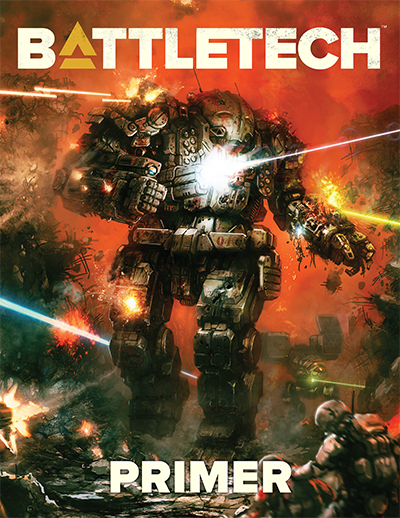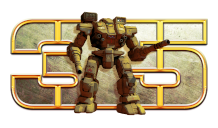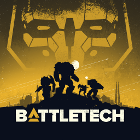- Home
- New To BattleTech?
- MUL
- Forums
- News
- Books
- Shrapnel
- Universe
- Downloads
- Characters
- Community
- Errata
- Links
- Gallery
Glossary of Clan Terms
The language of the Clans is based on what is known of Star League Standard English, but they have added many words unique to their culture. Some were adapted by the Kerenskys from the Russian language and military terminology. All these words represent the Kerensky’s efforts to express concepts they felt were lacking from Star League Standard English. The following list includes terms used by the warrior caste and other useful explanations of Clan concepts that were integral to the Wars of Reaving. This list is not exhaustive, and does not reflect the many differences in terminology existing between the various Clans.
- Abjuration, Trial of
- When a problem within a caste or Clan can be resolved by no other process, the troublesome element may be ejected from Clan society through a Trial of Abjuration. The target of the ritual is stripped of rank and caste, which places them outside Clan law, and is usually forcibly ejected from Clan territory. Members of the Clans may no longer even speak the name of the abjured member of Clan and, in the case of warriors, their genetic material is purged from the gene pool. A Clan also may abjure a warrior for negligence of duty or conduct unbecoming a warrior.
The results of a Trial of Abjuration may be overturned by the clan Council that enacted it or by the Grand Council. - Abtakha
- A warrior adopted into the warrior caste of the Clan that captured them is known as abtakha.
- Annihilation, Trial of
- The ultimate punishment in Clan society, the Trial of Annihilation calls for the destruction of the accused. Such trials may only be carried out following a unanimous vote of the Clan or Grand Council, and may be invoked only for the most heinous crimes. Such sanctions have been declared against individuals, Stars, and Clusters, and rarely used against an entire Clan. Everything associated with the target—possessions, genetic material and descendants—is destroyed, and no member of any Clan may speak the name of those annihilated.
- Batchall
- The batchall is the ritual by which Clan warriors issue combat challenges. Though the challenge may take many forms, in most cases the batchall begins with the attacker identifying himself, announcing the objective of the trial and requesting to know what forces stand against him. The defender must reveal the forces they intend to use in the trial, and also may choose the site of the battle. The defender also has the right to ask the attacker to ante up a prize of equal value against the possibility the defender wins the trial, though the challenged party rarely takes advantage of this opportunity.
When the batchall is complete, the attacking and defending units bid among themselves to determine who will participate in the battle. The subcommander who bids lowest wins the right and responsibility of the battle, a practice that minimizes losses.
Because Inner Sphere troops regularly use deception and other tactics the Clans consider dishonorable, many Clans abandon the batchall when fighting Inner Sphere and dezgra foes. - Bloodcount
- The Bloodcount is the number of active Bloodrights associated with a Bloodname, and thus the number of individuals who may use that Bloodname. Traditionally, this is twenty-five, but in the case of inferior Bloodnames the count may be as few as five. The process for reducing a Bloodcont is known as Reaving, and the process for increasing it is called Propogation. A Bloodcount may also be reduced by Abjuration or by an ilKhan’s decree.
- Bloodname
- A Bloodname is the surname associated with a Bloodright, descended from one of the eight hundred and two warriors who stood with Nicholas Kerensky to form the Clans. A warrior must win the use of a Bloodname in a Trial of Bloodright. Only Bloodnamed warriros may sit on Clan Councils or hold the post of Loremaster, Khan or ilKhan, and only the genetic material from the Bloodnamed is used in the warrior caste eugenics program.
- Bloodname House
- The warriors bearing or eligible to bear a particular Bloodname form a Bloodname House. The House acts as a substitute family for the warriors and exerts considerable political influence in the Clans. In some Clans, most notably the Fire Mandrill Kindraas and the Cloud Cobra Cloisters, groups of Bloodname Houses band together to form larger, more powerful associations.
After the first generation, Bloodnames are determined matrilinealy and so a warrior may only claim membership of one Bloodname House. - Bloodheritage
- The history of the Bloodnamed warriors of a specific Bloodright is known as the Bloodheritage.
- Bloodright
- A specific “lineage” of a Bloodname is known as a Bloodright. Unlike the conventional Clan Bloodname lineage, the members of a Bloodright need not be directly related to each other, only to the original founder of the Bloodname. Each Bloodname may consist of up to twenty-five Bloodrights.
- Bloodright, Trial of
- The Trial of Bloodright is a series of one-on-one, single-elimination duels fought by warriors to win possession of a Bloodname. Each competition consists of thirty-two entrants, the majority of which are nominated by the existing Bloodnamed warriors of the House. The Head of the House (or Clan Loremaster) nominates all but one of the remaining entrants, and the thirty-second slot is filled by the winner of a Grand Melee.
- Bondcord
- The woven bracelet worn by bondsmen is known as a bondcord. Warrior caste bondsmen wear the three-strand bondcord on their right wrist, with the color and patterning of the cords signifying the Clan and unit responsible for the warrior’s capture. The cords represent integrity, fidelity, and prowess, the bondholder may cut each strand as he or she feels the bondsman demonstrates the associated quality. According to tradition, when the final cord is severed, the bondsman is considered a free member of his or her new Clan and adopted into the warrior caste. Each Clan follows this tradition to varying degrees.
- Bondholder
- A bondholder is the individual, traditionally the member of the warrior caste, responsible for the bondsman’s capture, to which he or she “belongs.” The Clan considers the bondholder responsible for the actions, education, and punishment of the bondsman.
Khans have the option to step in and take over as a bondholder if they believe the bondsman is of worth to the Clan. There is no limit to how many bondsmen a bondholder may have, though by tradition it is usually one. - Bondsman
- A bondsman is a prisoner held in a form of indentured servitude until released or accepted into the Clan. Most often, bondsmen are captured warriors who fulfill roles in the laborer or technician castes. Their status is represented by a woven bondcord, and they are obliged by honor and tradition to work for their captors to the best of their abilities.
- Bondsref
- The ritual by which a warrior avoids the fate of a bondsman is called bondsref. Because the Clans consider escaping after being captured dishonorable, bondsref allows the warrior to die before being given a bondcord, either by suicide or at the hands of an accomplice. Performing the ritual of bondsref after receiving a bondcord is considered cowardly and dishonorable, unless the bondholder gives his or her permission.
- Brian Cache
- A Brian Cache is a Clan equipment storage facility, usually one established during the demobilization process Kerensky created upon arriving in the Pentagon worlds. The name is derived from the Star League Castle Brian fortressess.
- Caste
- The Clans are divided into five castes: warrior, scientist, merchant, technician, and laborer, in descending order of influence. Each has many sub-castes based on specialized skills. The warrior caste is largely the product of the artificial breeding program; those candidates who fail their Trial of Positions are assigned to the scientist or technician caste, giving those castes a significant concentration of Trueborn members. Most of the civilian castes are made up of the results of scientist-decreed arranged marriages within the castes.
The children of all castes undergo intensive scrutiny during their schooling to determine the caste for which they are best suisted, though most end up in the same caste as their parents. This process allows children born to members of the civilian castes to enter training to become warriors, though they belong to the less-prestigious ranks of the freeborn. - Chalcas
- Someone or something that challenges the Clan caste system is known as chalcas.
- Circle of Equals
- The area in which a trial takes place is known as the Circle of Equals. It ranges in size from a few meters for personal combat to tens of kilometers for large-scale trials. Though traditionally a circle, the area can be any shape.
- Codex
- Most often worn as a bracelet, a codex is a warrior’s identification and service record. It includes details of their bloodline, House, and generation as well as an electronic representation of their DNA for identification. Lower caste members have a simpler version of the codex, used primarily for identification purposes.
- Crusader
- A Crusader is a Clansman who espouses the invasion of the Inner Sphere and the re-establishment of the Star League by military force. Most Crusaders are contemptuous of the people of the Inner Sphere, whom they view as barbarians, and of freeborns within their own Clans.
- Cutdown
- The cutdown is the accepted minimum force necessary to win a trial. Bidders who force their opponents below the cutdown are considered clever, while those who win trials with forces below the cudown receive great honor.
- Dezgra
- Any disgraced individual or unit is known as dezgra. Disgrace may come through refusing orders, failing in an assigned task, acting dishonorably, or demonstrating cowardice.
- Elemental
- The large, muscular infantry derived from the Clan artificial breeding program are called Elementals. Their battle armor suits also are referred to as Elementals.
- Enhanced Imaging (EI)
- EI refers to implanted neurocircuitry that allows a MechWarrior or aerospace pilot to better control his or her machine. Though the implants, which often resemble soft-glowing ornate body tattoos, greatly enhance a warrior’s reaction time, evidence suggests that EI eventually causes paranoia and outright madness.
The EI circuitry is a requirement for those warriors who pilot ProtoMechs. - Eugenics Program
- The Clans believe strongly in the principals of eugenics, the improvement of the population by controlled breeding. The Clans implement such a program along two distinct strands. The warrior caste uses and artificial breeding program based on genetic engineering and incubation in artificial wombs in order to create the ultimate warriors. In the civilian castes, a system of mandatory arranged marriages provides a similar but less technical means of advancement. According to a strict definition, both of these methods may be called eugenics, but within the Clans only the artificial breeding program is commonly referred to as such.
- Founder, The
- The Founder is the Clan name for Nicholas Kerensky, who founded the Clans.
- Freebirth
- Freebirth is a Clan epithet used by Trueborn members of the warrior caste to express disgust or Frustration. For one Trueborn to use this curse to refer to another Trueborn is considered a mortal insult.
- Freeborn
- An individual conceived and born by natural means is referred to as freeborn. Its emphasis on the artificial breeding program allows Clan society to view such individuals as second-class citizens.
- Giftake
- Giftake refers to the sample of DNA taken from a warrior who died with great glory in combat.
- Grand Council
- The Grand Council is the body responsible for governing the Clans as a whole. It consists of the assembly of Khans, two from each Clan, as well as the ilKhan (if one exists). Its authority covers any matters involving more tha one Clan, and it also determines general policy for Kerensky’s descendants. The Grand Council serves as the highest court of the Clans.
- Great Father, The
- The Great Father is the Clan name for Nicholas Kerensky’s father, Alexandr, the general who led the SLDF into exile.
- Grievance, Trial of
- The Trial of Grievance is used to settle disputes between two parties. The victorin the match is deemed to be in the right. Often such trials are fought over points of honor and often to the death.
- Hegira
- Hegira is the rite by which a defeated foe may withdraw from the field of battle without further combat and with no further loss of honor.
- ilKhan
- The ilKhan is the war leader of the Clans, elected from the members of the Grand Council. He or she also serves as arbiter between Clans in times of crisis, acting with the power of the Grand Council. The ilKhan enjoys wide-ranging powers in military matters, but not absolute; the ilKhan answers to the Grand Council and his authority is limited to those matters ordinarily belonging to the Grand Council. The ilKhan normally may not interfere in events deemed internal to a Clan, but when the martial code is in effect they operate largely unhindered.
- Isorla
- The spoils of battle, including bondsmen, claimed by the victorious warriors is called isorla.
- Keshik
- The Keshiks comprise a combination of bodyguard and command unit, usually serving a Khan. Traditionally, a Khan commands a Keshik, but in practice a Star Colonel oversees day-to-day matters. Keshiks range from Trinary to Cluster size.
- Khan/saKhan
- Each Clan Council elects two of its number as Khans, who serve as rulers of the Clan and its representatives on the Grand Council. Traditionally, these individuals are the best warriors in the Clan, but in practice many Clans instead elect their most skilled politicians. The senior Khan acts as the head of the Clan, overseeing relationships between castes and Clans. The junior Khan, known as the saKhan, acts as the Clan’s warlord. The senior Khan decides the exact distribution of tasks and may assign the saKhan additional or different duties.
- Kindraa
- A Kindraa is a political-military faction within Clan Fire Mandrill composed of one or more Bloodname Houses.
- Kurultai
- A kurultai is a Clan war council. A Grand Kurultai is a war council involving all of the Clans. Traditionally, Grand Kurultai are held in the Hall of Khans on Strana Mechty and may only be convened by the petition of three of more clans. An ilkhan may call a Grand kurultai at any time or place.
- Loremaster
- The Loremaster is the keeper of Clan laws and history. They play a key role in investigations and trials and is the only individual allowed to take action against active Khans. Unlike the Khans, who are nominally above the political infighting in the Grand Council, the Loremaster can take a proactive role in any inquiries and trials, acting as either advocate or inquisitor. Traditionally, however, the Loremaster does not vote on issues save in the event of a tie, at which point his vote decides the issue.
In times of crisis, legal provisions allow for the Loremaster to take the place of a Khan in the event of incapacity, death, or censure. As a result, many ambitious warriors view the post of Loremaster as a stepping stone to a Khanship. - Martial Code
- The Martial Code is a collection of rules and laws governing Clan actions in times of war. Its primary goal is to minimize the political prevarication that often accompanies Grand Council meetings, forcing the participants to keep to the matter at hand and to carry out business with the minimum of fuss. When in effect, it also grants the ilKhan extraordinary powers such as the right to dismiss any charges brought before the Clan or Grand Councils they deem frivolous.
- Master Codex
- The master codex comprises the master files of the Clan breeding program, mapping the DNA and genealogy of every Trueborn warrior, alive or dead.
- Melee
- A melee is a free-for-all battle offering no targeting restrictions and ignoring the rules of zellbrigen. Any trial may become a melee if a participant violates zellbrigen by firing on a target already engaged in combat with another participant. The battle to determine the thirty-second place in a Trial of Bloodright is called a Grand Melee.
- Oathmaster
- The Oathmaster serves as the honor guard for any official Clan ceremony. They administer all oaths taken at the ceremony and are traditionally the oldest and most experienced Bloodnamed warrior at the gathering.
- Position, Trial of
- There are two forms of the Trial of Position. The first—also known as the blooding—determines if a warrior candidate is qualified to take his or her place as a member of the warrior caste. Failure in that trial results in demotion to a civilian caste; success (defeating one or more opponents) determines both status and rank.
The second form of Trial of Position, known as testing, is held periodically and determines whether a warrior is qualified to maintain his or her rank. Those who perform as expected against targets based on role, rank, and age maintain their rank, while those who perform better than expected are promoted. Those who perform more poorly than expected are demoted. A non-officer MechWarrior, pilot, Elemental, or ProtoMech warrior who tests down are relegated to a non-combat role or else transferred to a civilian caste. - Possession, Trial of
- A Trial of Possession resolves disputes between two parties over ownership or control. These can include equipment, territory, or even genetic material. The traditional batchall forms the core of the trial in order to encourage the participants to resolve the dispute with minimal use of force.
- Propagation
- Propagation is the ritual of increasing the Bloodcount associated with a particular Bloodname. A Bloodcount reduced by Reaving may be increased on the advice of the scientist caste and after a vote of the Grand Council. This motion may be opposed by a Trial of Refusal known as a Trail of Propogation, but no penalty attaches to either the aggressor or the defender.
- Quiaff/Quineg
- These are grammatical constructs associated with rhetorical questions. They are a formalized version of language structures used with spoken language, intended to remove any ambiguity. When the speaker expects a negative answer, he or she ends the sentence with quineg; when expecting a positive answer, the sentence ends in quiaff.
- Reaving
- Reaving is the ritual of reducing the Bloodcount associated with a particular Bloodname. Originally established to mitigate the impact of a poorly performing Bloodname, over time the Reaving has become a political tool used to control the number of warriors from a single Bloodname House, and therefore votes, in Clan Councils. A Reaving is called by a Bloodname House (and more recently through precedent, by a Clan) against a Bloodname House that has announced a Trial of Bloodright. The Grand Council debates the merits of the Bloodname and the matter is traditionally resolved by a Trial of Refusal known as the Trial of Reaving, based on the results of the Council vote. If the pro-Reaving force wins the trial, the targeted Bloodname’s Bloodcount is reduced by one and the Trial of Bloodright is canceled. If the defending force wins, the Trial of Bloodright takes place as scheduled and the Bloodname House that called for the Reaving suffers sanctions.
- Refusal, Trial of
- Any decision made by a Clan Council or the Grand Council may be challenged by a member of that body. The Trial of Refusal epitomizes the Clan belief that might makes right, with the victor of the trial being regarded as in the right. The odds of the battle are determined on a pro-rated basis, with the forces of the two sides matched according to the ration of winning and losing votes. The challenger announces what forces they will use and the defender can field forces proportionate to their margin of success in the vote. For example, a Trial of Refusal against a decision that passed five-to-one could give the defender a force five times the size of that used by the challenger. In practice, the result of bidding among those wishing to defend the decision usually shifts the odds in favor of the challenger.
- Remembrance, The
- The Remembrance is an ongoing heroic saga that describes Clan history from the time of the Exodus to the present day. Each Clan maintains its own version, reflecting its opinions and perceptions of events. Inclusion in The Remembrance is one of the highest honors possible for a member of the Clans. All Clan warriors can recite passages from The Remembrance from memory, and written copies of the book are among the few non-technical books allowed in Clan society. These books are usually lavishly illustrated in a fashion similar to the illuminated manuscripts and Bibles of the Terran medieval period. Warriors have been known to paint passages of The Remembrance on the sides of their war machines.
- Ristar
- A gifted warrior on his way to a high position in the Clan is referred to as a ristar: literally, a rising star.
- Safcon
- Safcon is a Clan ritual that allows troops to land on a world unmolested in advance of a trial. In the absence of safcon, the incoming DropShips, JumpShips, and WarShips are open to attack. Even in those cases when Clan ships are not approaching a world to engage in a trial, the inbound vessels may broadcast a “beam of neutrality”—a message indicating non-hostile intentions—when they are attempting to make planetfall while avoiding any hostile actions from the occupying troops.
- Seyla
- Seyla is a ritual response in Clan ceremonies. The origin of this phrase is unknown, though it may come from the Hebrew notation “selah,” thought to be a musical notation or a reference to pause and contemplate.
- Sibko
- A group of Trueborn warrior caste children raised and trained together is known as a sibko. In many Clans, sibkos are produced from the same geneparents and thus are literally siblings. Usually only four or five warriors on average pass their initial Trial of Position.
- Sibkin
- Members of the same sibko.
- Solahma
- Clan warriors considered too old to serve in mainstream units are assigned to solahma units. The members of such units generally seek suicide missions in order to die in combat, but most often they serve as garrison troops.
- Stravag
- A Clan epithet, probably a corruption of stran, meaning independent, and vagon, meaning birthing.
- Surkai
- Surkai is the rite of forgiveness. When two parties disagree, or when one offends the other, Clan society expects the opponents to undergo surkai. As a matter of honor, the offending party admits his wrongdoing and requests punishment. The Clan views those who do not request surkai as a divisive influence and finds another way to deal with such members. Actions too severe to be excused by surkai result in a Trial of Grievance.
- Surkairede
- Surkairede, the Rede of Forgiveness, is the honor-bound oath associated with surkai. It binds two parties and ensures that the offender suffers no further disgrace from the offense once he or she accepts punishment.
- Touman
- The fighting arm of a Clan is known as the touman.
- Trothkin
- Used formally, trothkin refers to members of an extended sibko. It is more commonly used to denote members of a gathering, and warriors also frequently use it when addressing someone they consider a peer.
- Trueborn/Truebirth
- A warrior born of the Clan’s artificial breeding program is known as a Trueborn. In less formal situations, the Clans use the term Truebirth.
- Warden
- A Warden is Clansman who believes that the Clans were established to guard the Inner Sphere from outside threats rather than to conquer it and re-establish the Star League by force. Most Wardens were therefore opposed to the invasion of the Inner Sphere in 3050, known as Operation REVIVAL.
- Zellbrigen
- Zellbrigen is the body of rules governing duels. These rules dictate that such actions are on-on-one engagements, and that any warriors not immediately challenged should stay out of the battle until an opponent is free.
Once a Clan warrior engages a foe, no other warriors on his side may target that foe, even if it means allowing the death of the Clan warrior. Interfering in a duel by attacking a foe that is already engaged constitutes a major breach of honor, usually resulting in loss of rank, and also opens the battle to a melee.
 BattleTech is a science-fiction “space opera”: a factional, militarized universe set in the thirty-first century, a future where humanity has spread to the stars and spawned titanic interstellar empires, each nation controlling hundreds of worlds across a region of space stretching a thousand light years and beyond.
BattleTech is a science-fiction “space opera”: a factional, militarized universe set in the thirty-first century, a future where humanity has spread to the stars and spawned titanic interstellar empires, each nation controlling hundreds of worlds across a region of space stretching a thousand light years and beyond.
Initially published over thirty years ago as a tabletop board game, BattleTech has gone on to become one of the gaming industry’s most important and longest-lasting science-fiction universes.
Be sure to check out the latest BattleTech Releases and the Coming Soon page for the newest BattleTech products.






